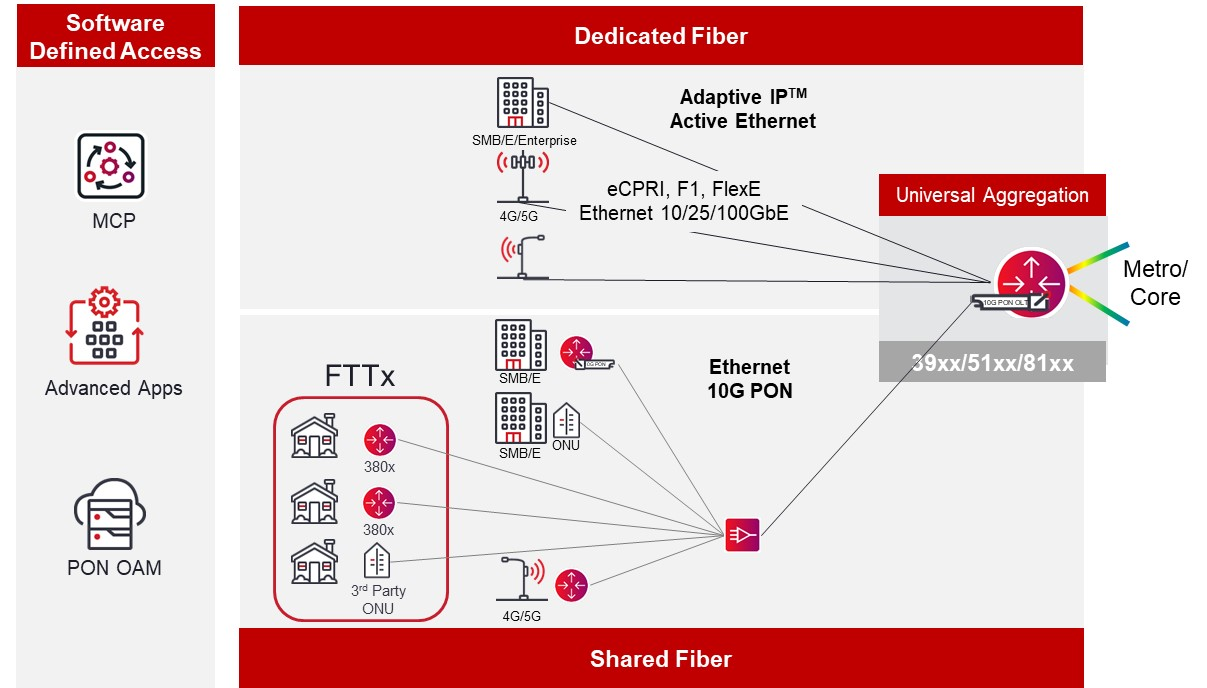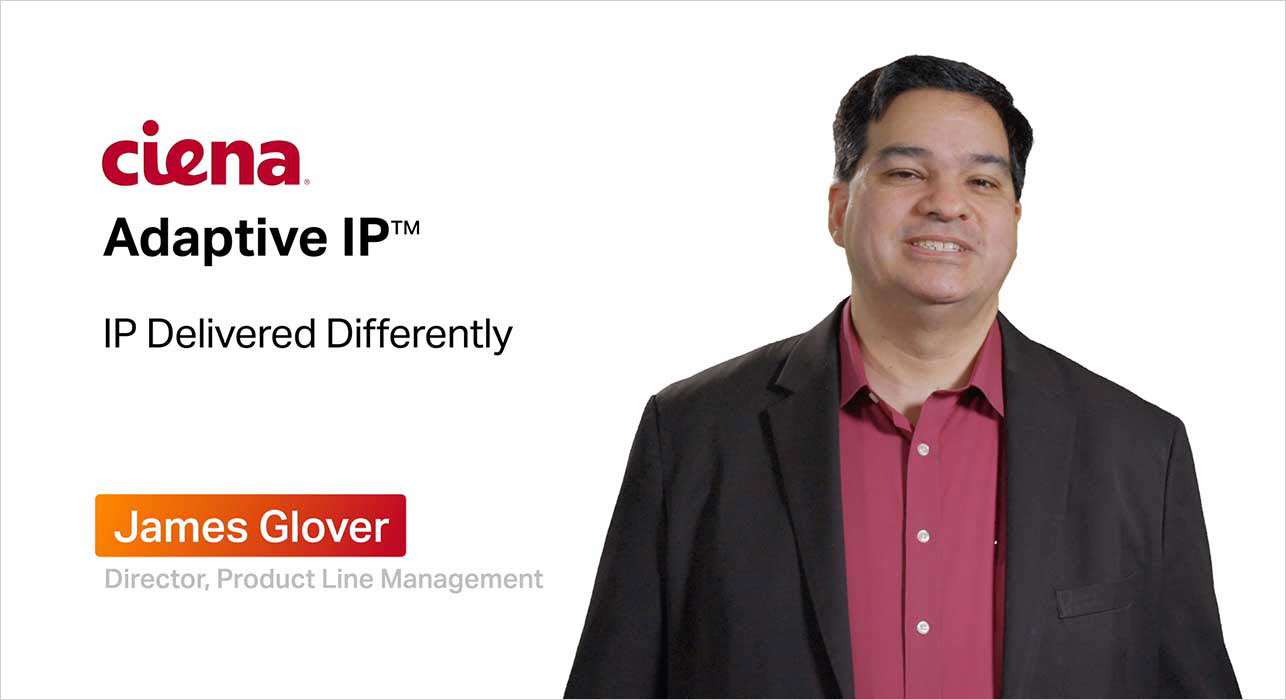What is universal aggregation?
Network providers must modernize their networks to support the growing demand for ever-faster internet connections, increasing numbers of higher-resolution streaming media devices, the rapid shift to the cloud, mobile, and many more new services. At the same time, there is a demand for better user experience as network providers race to remain competitive. As a result, universal aggregation will play an increasing role in addressing these challenges by providing greater capacity while reducing network costs.

Universal Aggregation solution
The challenges of multi-vendor, multi-layer network infrastructure
![]() For most network providers, their environment is a very challenging one with multiple vendors deployed for
TDM, Ethernet, Passive Optical Network (PON), and IP. It is no wonder performance and reliability are increasingly valued as providers must manually configure, shape, and optimize packet services while maintaining private line services. Most of these environments are capped investments making it difficult
to support, especially as sourcing the associated equipment and technical support becomes more difficult.
For most network providers, their environment is a very challenging one with multiple vendors deployed for
TDM, Ethernet, Passive Optical Network (PON), and IP. It is no wonder performance and reliability are increasingly valued as providers must manually configure, shape, and optimize packet services while maintaining private line services. Most of these environments are capped investments making it difficult
to support, especially as sourcing the associated equipment and technical support becomes more difficult.
![]() Another business challenge for network operators is having to deploy multiple platforms for different types of services.
Managing multiple interconnected hardware and software deployments across complex environments increases operational cost, complexity, and troubleshooting tasks. Service margins will continue to erode, resulting in unsustainable financial pressures that negatively impact margins and the bottom
line.
Another business challenge for network operators is having to deploy multiple platforms for different types of services.
Managing multiple interconnected hardware and software deployments across complex environments increases operational cost, complexity, and troubleshooting tasks. Service margins will continue to erode, resulting in unsustainable financial pressures that negatively impact margins and the bottom
line.
![]() Traditional TDM, Ethernet, PON, and IP network architectures are static, inflexible, and unable to scale quickly
enough to support new high-bandwidth and low-latency services. Adding capacity or deploying new revenue-generating services, such as IoT or 5G, becomes difficult or impossible because network operators
Traditional TDM, Ethernet, PON, and IP network architectures are static, inflexible, and unable to scale quickly
enough to support new high-bandwidth and low-latency services. Adding capacity or deploying new revenue-generating services, such as IoT or 5G, becomes difficult or impossible because network operators
must deploy new or additional hardware and software, and build additional overlay networks to aggregate
traffic from different types of services.
![]() Building and operating standalone network architectures to support different types of services (such
as private line, business, mobile, residential, and shared fiber or PON services) creates a costly, complex, and inefficient network footprint that increases both CAPEX and OPEX. Multiple network architectures also mean increased management requirements and associated complexity, which reduces margins
and negatively impacts the bottom line.
Building and operating standalone network architectures to support different types of services (such
as private line, business, mobile, residential, and shared fiber or PON services) creates a costly, complex, and inefficient network footprint that increases both CAPEX and OPEX. Multiple network architectures also mean increased management requirements and associated complexity, which reduces margins
and negatively impacts the bottom line.
Traditional network architectures are often unable to aggregate traffic from new types of services without additional hardware and software deployments in the network. This affects time-to-market for new service revenues and reduces customer satisfaction for existing customers, placing current profitable revenue streams at risk.
As operators continue to evolve their networks, their goal is to increase service speeds by investing heavily in their access networks to accommodate future service growth and ensure their advertised speeds and services surpass the competition by avoiding infrastructure sprawl and complexity. Operators will need a network architecture that leverages universal aggregation to achieve this goal.
What is universal aggregation?
Universal aggregation provides increased choice and control of tangible business value assets like Adaptive IP™, WaveLogic™ 5 Nano coherent optics, and other pluggable assets for dedicated and shared fiber or 10G PON. By supporting all services, universal aggregation expands the network provider’s application space and competitiveness. This gives providers choices to enable with a smaller footprint, increased capacity, and larger interconnect scale in routing and switching platforms that automate and simplify deployment and turn-up tasks.
Increasingly, operators are looking to universal aggregation solutions to solve their business challenges. With the right speeds, feeds, and routing capability to support traffic from multiple service types, including private line, business services, mobile, shared fiber, or PON. Universal aggregation unifies packet and transport infrastructure. As a converged network approach, universal aggregation enables aggregation of traffic from TDM, IP, and Ethernet services using dedicated and shared fiber on the same, cost-effective routing and switching platform. Best of all, universal aggregation enables a simple, compact, scalable, and efficient programmable infrastructure with coherent optic transport, switching, and routing capabilities for services now and in the future.
The benefits of universal aggregation
Legacy networks hinder revenue growth opportunities, consume budget, and degrade the customer’s Quality of Experience (QoE), which can lead to the loss of existing and/or new customers.
The value of universal aggregation is simple—choice. A universal aggregation solution saves providers from having to build different access networks for different services. It allows providers to choose different fiber for different services instead of a unified fiber for those same services. Providers may choose aggregation for some services or all services, from closed Network Management Software (NMS) to open-source streaming telemetry. Universal aggregation can transform the process of network evolution for all services and can provide the following benefits:
- Increase choice and business value control
- Create a smaller footprint with increased capacity and larger interconnect scale
- Further automate and simplify deployment and turn-up
- Expand the application space and competitiveness
Modernizing from legacy networks to universal aggregation creates a smarter, more agile network—and a more innovation-ready infrastructure that responds to demand when needed. Ciena offers best-in-class routing and switching platforms, enabling choice and control of tangible business value assets like coherent optics, Adaptive IP, and pluggables for dedicated and shared fiber or 10G PON.
Remove constraints and bring more value to your network edge today. Ask us how Ciena helps evolutionize your routing and switching network.
What’s in your network?







